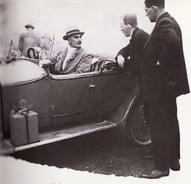
british anzani archive:

good to miss. So the British Anzani 1496cc four cylinder side-valve 11.9hp
motor was to be built at the Willesden factory and an order was placed by AC in
1919 for 2,000 of them. In recognition of this order AC Cars were given 2000
shares in Anzani and John Weller and fellow AC director Selwyn Francis Edge
took up their places on the British Anzani board of directors.
Other events were taking place though and in 1923 Gustave Maclure resigned
from British Anzani to set up his own company (with fellow Anzani director
Richard Simpkin) just around the corner from his old employer in Willesden. He
was to manufacture a new engine under the Plus-Power Engine Company
name and in less than a year the new engine was ready. It came to the attention
of Archie Frazer-Nash who was on the look out for an engine for his cars and
Maclure’s Plus-Power (a 1500cc OHV) which was in many respects just a more
sporting version of his original design suited the dashing Frazer-Nash perfectly.
Events in the motor industry were overtaking Plus-Power however and
independent manufacturers were falling by the wayside with the effects of the
cheaper mass produced Morris and Austin cars. In less than a year Plus-Power
were calling in the receivers and Maclure was a much poorer man for his
venture. The company did not have limited liability and with debts rising the
directors decided to pull out quickly before the damage grew too large. They
had sold engines to only three companies and of these Frazer-Nash was by far
the biggest customer and it was to them that Maclure turned asking them to buy
his ailing company. Nash refused and meanwhile H. J. Aldington, a fellow
Frazer-Nash director, invited Nash to try a car powered by the British Anzani
and from then on British Anzani supplied Frazer-Nash with their engines.
In January 1925 AC cars managing director Mr S. F. Edge decided to
manufacture their own version of the British Anzani engine at the Aylesbury
factory of the Cubitt Car Company (in which he had a financial interest) and he
immediately cancelled the 30 engines a month order from Anzani which caused
a receiver to be appointed in February 1925. Edge had had a team of engineers
strip down an Anzani engine to make patterns and they then redesigned the
exterior slightly to avoid direct comparison with the original. To add to the pain
felt by Anzani the managing director of Cubitt’s approached Gustave Maclure to
remedy some teething problems they had had with the new engine and so
monoplanes, Mignet in their HM14, and Hawker powered their little Cygnet
biplane with it in 1924. The same year it also appeared in the Bristol Prier-
Dickson. The design was eventually purchased in 1938 by the Luton Aircraft
Company of Gerrards Cross, who had been fitting it to their Luton Minor and
Luton Buzzard range of homebuild light aircraft popularly known at the time as
Flying Fleas. The engine was modified yet again by Luton with a slight over-
bore and fitted with dual ignition and a different carburettor and was marketed
as the Luton-Anzani. Luton went out of business during WWII.
In August 1919 Mr Ramsay resigned and British Anzani was reformed as a
limited company under the joint control of Mr R.H. Simpkin (also general
manager of the British Caudron factory at Cricklewood, north London) and
Hubert Hagens.
The story of how Anzani came to design a car engine is slightly curious. During
their search for new business a man approached Gustave Maclure and
suggested that if he were to build an engine of a certain type at a certain price
then this person would certainly purchase them from him for the new car he was
considering building. Maclure designed the 11.9 hp side-valve saying later “the
side-valve Anzani was the product of everything I learnt at Rolls Royce,
especially from Royce. You could say it was a Rolls Royce design.” It was a
gem of an engine; strong, light, reliable and tunable it was just a pity that his
‘customer’ had no company, no car and no money to pay for his work.
Fortunately Maclure was to hear that someone
else might find a use for his engine...
In 1918 AC Cars directors John Weller and John
Portwine had decided to replace the French Fivet
engine in their light car and they were designing a
1500cc 6 cylinder engine for this purpose. The
engine (which was later to become the classic 2
litre AC engine) was costing them a fortune to
develop and the offer of an off-the-peg
replacement while the six was perfected was too







At the turn of the century John Weller was a well known engineer
and along with his brother was in the business of building, repairing
and servicing motor cycles and cars in the West Norwood area of
London. Financial backing came from local businesman John
Portwine. In 1904 the successful three-wheeled Autocarrier
commercial delivery vehicle was launched and the company name
changed to Autocarrier & Accessories. In 1907 the name ‘AC’ was
adopted for the first time. The company moved to their famous
Thames Ditton site in 1911.







